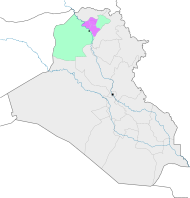Batnaya
Batnaya | |
|---|---|
Village | |
Tel Kaif District |
Batnaya (
In the village, there are Chaldean Catholic churches of Mar Quriaqos and Mart Maryam.[2] The Mar Oraha Monastery is also located near the village.
Etymology
Several theories have been put forward for the origin of the name of the village as local traditions suggest it may derive from "beth" ("place" in Syriac) and "ṭeṭnāyé" ("clouded corneas" in Syriac), thus translating to "the place of those who have clouded corneas", which is believed to allude to eye diseases caused by plaiting reeds, or could be a combination of "beth" and "ṭnānā" ("zeal" in Syriac) and translate to "place of zeal".[3] The village's original name, Beṯ Maḏāye, is argued by the French Syriacist Jean Maurice Fiey to derive from "beth" and "Madaye" ("Medes" in Syriac) and thus translates to "place of the Medes".[3]
History
Batnaya is first attested with the name Beṯ Maḏāye in the History of Beṯ Qōqā in the seventh century AD, at which time the village is believed to have been converted to Christianity by Mar Oraha (Saint Abraham the Mede).[2][4] Jean Maurice Fiey argues that the name Beṯ Maḏāye suggests that the village was inhabited by Yazidis prior to their conversion.[3] Batnaya is also identified as the Beṯ Maḏāye mentioned in a letter of Catholicos Ishoyahb II (r. 628–645).[3] The church of Mar Quriaqos, which is believed to have originally been a monastery,[2] is mentioned in 1474, in which year a manuscript was copied there by the priest Īshō, son of Isaac, of Hakkari.[5]
The village was populated by
By 1961, the population of Batnaya had reached 3104 people.
In cooperation with Canadian, French, and American teams, the Peshmerga subsequently set about clearing the village of mines and bombs planted by ISIL fighters.
Notable people
- Shlemon Warduni (b. 1943), Chaldean Catholic bishop
References
- ^ "باطنايا". Ishtar TV (in Arabic). Retrieved 11 August 2021.
- ^ a b c d e f g h "The Mar Qouryakos Church in Batnaya". Mesopotamia Heritage. Retrieved 14 August 2021.
- ^ a b c d Fiey (1975), p. 377.
- ^ Wilmshurst (2000), pp. 232–233.
- ^ a b c Wilmshurst (2000), p. 232.
- ^ a b Fiey (1975), p. 378.
- ^ Fiey (1975), p. 379.
- ^ Wilmshurst (2000), p. 199.
- ^ Fiey (1975), p. 376.
- ^ The Ferret. Retrieved 18 August 2021.
- ^ a b c John Pontifex (25 February 2020). "Iraq: ACN helps rebuild flattened Christian village". Independent Catholic News. Retrieved 18 August 2021.
- ^ "80-year-old dreams of the day her village will recover from ISIS war". Rudaw Media Network. 30 November 2018. Retrieved 18 August 2021.
- ^ "Restored houses bring families back home to Batnaya". United Nations Development Programme. 30 May 2019. Retrieved 18 August 2021.
- ^ "Population Project". Shlama Foundation. Retrieved 19 August 2021.
Bibliography
- Fiey, Jean Maurice (1975). Assyrie Chrétienne (in French). Vol. 2. Imprimerie Catholique de Beyrouth. Retrieved 15 August 2021.
- Wilmshurst, David (2000). The Ecclesiastical Organisation of the Church of the East, 1318–1913. Peeters Publishers.

